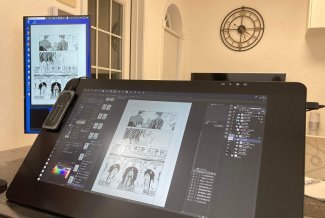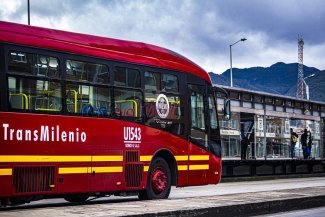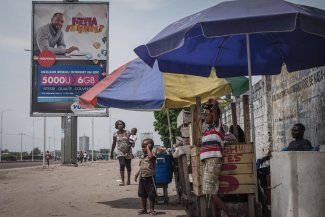Doctors and other medical staff protest the detention of their union leaders outside an appeal court in Nairobi, Kenya on 15 February 2017. A Kenyan court released seven doctors, who also served as trade union officials, after being jailed earlier that week for not calling off a strike by doctors working in public institutions.
A bitterly-fought 100-day doctors’ strike which paralyzed public health services in Kenya was finally called off last week after doctors’ unions and the government agreed to sign a new collective bargaining agreement (CBA) to improve pay and work conditions.
Some 5000 Kenyan doctors had been on strike since 5 December 2016 after the authorities failed to honour a 300 per cent salary increase for doctors as laid out in a 2013 CBA.
More than 2000 public health institutions in the country were affected by the strike, and in a country where few people can afford private health insurance, Kenya’s poorest and most vulnerable were hardest hit.
To end the strike, a Return To Work Formula (RTWF) was signed on 14 March. It grants doctors increased allowances of between US$560 and US$700 a month backdated from 1 January 2017. It also outlines details on promotion schemes for doctors, plans to improve healthcare facilities for patients, while ensuring protection against government reprisals for the striking doctors.
"We are happy that the union has put an end to the strike,” said Dr Ouma Oluga, head of the Kenya Medical Practitioners, Pharmacists and Dentists Union (KPMDU) at the signing of the agreement. “The terms and conditions relating to doctors have been honoured. We hope the country will not experience such a thing again."
Health Cabinet Secretary Cleopa Mailu also commented: “We cannot fathom the pain Kenyans experienced during the strike, but we hope that such a situation will never happen again in the history of the country. We know we have grievances, but we must learn how to resolve them."
While the doctors have gone back to work, the dispute is still not fully resolved. However, all parties have agreed to sign a new CBA within 60 days.
If the 2013 CBA is implemented, the lowest paid doctors will earn a monthly salary of between US$3119 and US$3187 in comparison to the current US$1225 to US$1435 a month. Meanwhile, the highest paid doctors will earn a monthly salary of US$3141 and US$ 5161.
Henry Rotich, Kenya’s treasury cabinet secretary, previously said that if implemented, such a pay deal would cost US$126 million annually – a bill that the government simply cannot afford to pay.
But the doctors insist that the strike wasn’t just about salaries. Dr Lukoye Atwoli , national secretary of the professional body, the Kenya Medical Association (KMA), told Equal Times: “There are other issues like the improvement of working conditions for the doctors, job structures and criteria for promotions, and address under-staffing in state hospitals,” he said.
A better healthcare system for Kenyans
Previous negotiations between the KMPDU and the government hit a deadlock earlier this year, with the government threatening to sack all of the striking doctors and even hire foreign doctors from countries like Cuba to replace them.
In February, seven KMPDU leaders were even jailed (and later released) for failing to call off the strike.
But the doctors say that the strike was really about securing a better health system for all Kenyans.
Because of corruption and inadequate resources, Kenya’s public hospitals are poorly equipped, while drug and staff shortages are chronic. The majority of counties in Kenya lack ambulances, while some health centres even lack basic resources such as malaria testing kits and even toilets.
The Kenya government currently allocates about 4 per cent of its budget towards healthcare but this falls far short of the targets set in the Abuja Declaration, which called for a minimum spend of 15 per cent of annual budgets on health in all African Union states.
News last October than more than US$55 million was stolen or fraudulently diverted from the health budget by senior officials caused uproar in Kenya. In one case, it was reported that more than US$9million meant for funding free maternity services was siphoned off and paid to individuals and personal companies.
Underlying issues
Things may look like they have returned to normal on the surface but the underlying issues at the heart of the strike still haven’t been resolved. Kenya only has about 10,000 doctors to serve a nation of 44 million people, and less than half of those doctors work in public hospitals.
According to the World Health Organization, Kenya has one doctor for every 5,000 patients compared to 2.5 per 1,000 in the US and around 3.5 per 1,000 in Europe. This figure is well below the World Health Organization’s recommendation of 100 doctors for every 100,000 patients.
Kenya, like many other countries on the African continent, is also suffering from a massive brain drain of its highly trained medical staff.
Between 2013 and 2016, 2,200 doctors left the country to work overseas, mostly in the UK, but also the United States, Canada, Australia and South Africa where they earn much higher salaries and enjoy better working conditions.
Francis Atwoli, Kenya’s secretary general of the Central Organization of Trade Unions (COTU) told Equal Times that the government is obliged to ensure the highest standard of healthcare for Kenyans, as guaranteed by the constitution.
“The government should engage more with the doctors and not issue threats like it has been doing,” Atwoli told Equal Times during the strike. “The strike was legal under the constitution and doctors have the right to demand their dues,” he said.
However, now that the strike is over, he is advising the doctors’ unions to do their utmost to ensure that the CBA is signed within the stated timeframe.
“The doctors should soften their stance in the negotiations if they want the CBA signed within 60 days,” he said, warning negotiators on both sides to avoid being “too rigid”.










